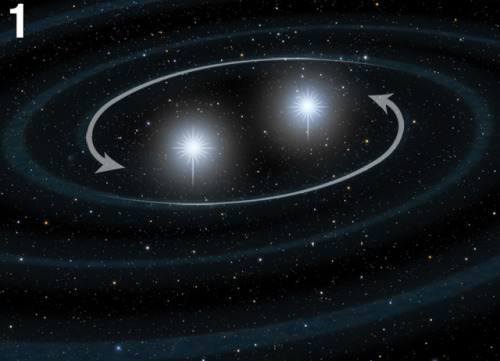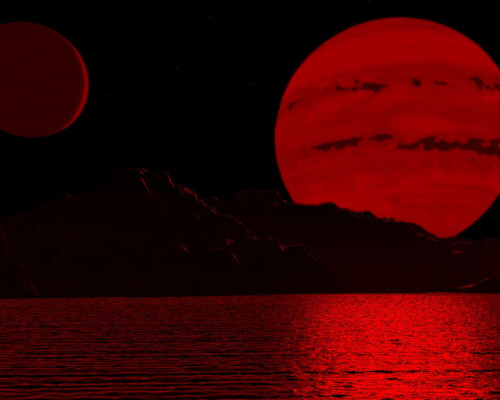Cosmicinsightz - Within The Cosmos

More Posts from Cosmicinsightz and Others

Wispy remains of a supernova explosion hide a possible ‘survivor.’ Of all the varieties of exploding stars, the ones called Type Ia are perhaps the most intriguing. Their predictable brightness lets astronomers measure the expansion of the universe, which led to the discovery of dark energy. Yet the cause of these supernovae remains a mystery. Do they happen when two white dwarf stars collide? Or does a single white dwarf gorge on gases stolen from a companion star until bursting? If the second theory is true, the normal star should survive. Astronomers used the Hubble Space Telescope to search the gauzy remains of a Type Ia supernova in a neighboring galaxy called the Large Magellanic Cloud. They found a sun-like star that showed signs of being associated with the supernova. Further investigations will be needed to learn if this star is truly the culprit behind a white dwarf’s fiery demise.
This supernova remnant is located 160,000 light-years from Earth. The actual supernova remnant is the irregular shaped dust cloud, at the upper center of the image. The gas in the lower half of the image and the dense concentration of stars in the lower left are the outskirts of a star cluster.
Image credit: NASA, ESA and H.-Y. Chu (Academia Sinica, Taipei)

Messier 51, Whirlpool in the Cosmos










What Happens When Planets, Stars, And Black Holes Collide?
“Brown dwarf collisions. Want to make a star, but you didn’t accumulate enough mass to get there when the gas cloud that created you first collapsed? There’s a second chance available to you! Brown dwarfs are like very massive gas giants, more than a dozen times as massive as Jupiter, that experience strong enough temperatures (about 1,000,000 K) and pressures at their centers to ignite deuterium fusion, but not hydrogen fusion. They produce their own light, they remain relatively cool, and they aren’t quite true stars. Ranging in mass from about 1% to 7.5% of the Sun’s mass, they are the failed stars of the Universe.
But if you have two in a binary system, or two in disparate systems that collide by chance, all of that can change in a flash.”
Nothing in the Universe exists in total isolation. Planets and stars all have a common origin inside of star clusters; galaxies clump and cluster together and are the homes for the smaller masses in the Universe. In an environment such as this, collisions between objects are all but inevitable. We think of space as being extremely sparse, but gravity is always attractive and the Universe sticks around for a long time. Eventually, collisions will occur between planets, stars, stellar remnants, and black holes.
What happens when they run into one another? Unbelievably, we not only know, we have the evidence to back it up!


Seven Worlds for TRAPPIST 1 : Seven worlds orbit the ultracool dwarf star TRAPPIST-1, a mere 40 light-years away. In May 2016 astronomers using the Transiting Planets and Planetesimals Small Telescope announced the discovery of three planets in the TRAPPIST-1 system. Just announced, additional confirmations and discoveries by the Spitzer Space Telescope and supporting ESO ground-based telescopes have increased the number of known planets to seven. The TRAPPIST-1 planets are likely all rocky and similar in size to Earth, the largest treasure trove of terrestrial planets ever detected around a single star. Because they orbit very close to their faint, tiny star they could also have regions where surface temperatures allow for the presence of liquid water, a key ingredient for life. Their tantalizing proximity to Earth makes them prime candidates for future telescopic explorations of the atmospheres of potentially habitable planets. All seven worlds appear in this artists illustration, an imagined view from a fictionally powerful telescope near planet Earth. Planet sizes and relative positions are drawn to scale for the Spitzer observations. The systems inner planets are transiting their dim, red, nearly Jupiter-sized parent star. via NASA
js




This image shows what it might look like standing on the surface of a planet orbiting a brown dwarf star. An alien moon can also be seen in the sky. The brown dwarf gives off such feeble visible light it is difficult to see any of the landscape except for the reflection in the water.
credit: Jeff Bryant

-
 eventualeden reblogged this · 5 years ago
eventualeden reblogged this · 5 years ago -
 queen-of-alagaesia liked this · 5 years ago
queen-of-alagaesia liked this · 5 years ago -
 fanartofthelostcities liked this · 5 years ago
fanartofthelostcities liked this · 5 years ago -
 a-golden-bear liked this · 5 years ago
a-golden-bear liked this · 5 years ago -
 timtoms liked this · 5 years ago
timtoms liked this · 5 years ago -
 otherlandshark liked this · 5 years ago
otherlandshark liked this · 5 years ago -
 m-l-e-p liked this · 5 years ago
m-l-e-p liked this · 5 years ago -
 blazeonmars reblogged this · 5 years ago
blazeonmars reblogged this · 5 years ago -
 blazeonmars liked this · 5 years ago
blazeonmars liked this · 5 years ago -
 spookydisasteronmain liked this · 5 years ago
spookydisasteronmain liked this · 5 years ago -
 windingvalley-moved liked this · 5 years ago
windingvalley-moved liked this · 5 years ago -
 innerlightawakening reblogged this · 5 years ago
innerlightawakening reblogged this · 5 years ago -
 innerlightawakening liked this · 5 years ago
innerlightawakening liked this · 5 years ago -
 gia-is-a-punk-rocker liked this · 5 years ago
gia-is-a-punk-rocker liked this · 5 years ago -
 no-longer-here-moved-to-alt liked this · 5 years ago
no-longer-here-moved-to-alt liked this · 5 years ago -
 void-tiger liked this · 5 years ago
void-tiger liked this · 5 years ago -
 erdnaaa liked this · 5 years ago
erdnaaa liked this · 5 years ago -
 intheirhonor reblogged this · 5 years ago
intheirhonor reblogged this · 5 years ago -
 intheirhonor liked this · 5 years ago
intheirhonor liked this · 5 years ago -
 thewishfulthinkerisonthehall reblogged this · 5 years ago
thewishfulthinkerisonthehall reblogged this · 5 years ago -
 eventualeden reblogged this · 5 years ago
eventualeden reblogged this · 5 years ago -
 asseenelsewhere liked this · 5 years ago
asseenelsewhere liked this · 5 years ago -
 lord-of-the-science-blog liked this · 5 years ago
lord-of-the-science-blog liked this · 5 years ago -
 a-universe-of-almosts liked this · 5 years ago
a-universe-of-almosts liked this · 5 years ago -
 lifeofhancomic liked this · 5 years ago
lifeofhancomic liked this · 5 years ago -
 shawnarichauthor liked this · 5 years ago
shawnarichauthor liked this · 5 years ago -
 jeebssred liked this · 5 years ago
jeebssred liked this · 5 years ago -
 thecozynerd liked this · 5 years ago
thecozynerd liked this · 5 years ago -
 fagdykefrank liked this · 5 years ago
fagdykefrank liked this · 5 years ago -
 notisaidthechicken liked this · 5 years ago
notisaidthechicken liked this · 5 years ago -
 mayshamrock reblogged this · 5 years ago
mayshamrock reblogged this · 5 years ago -
 mayshamrock liked this · 5 years ago
mayshamrock liked this · 5 years ago
a collection of all cosmic ephemeralities and phenomenons. a blog dedicated to exploring the vastness of the universe
66 posts